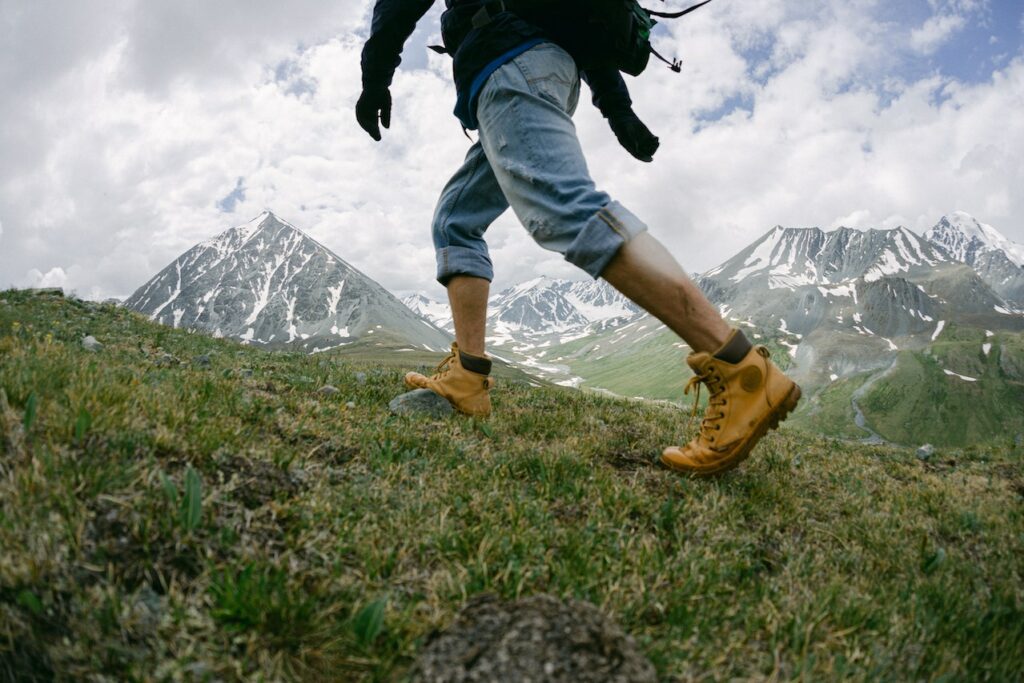Table of Contents
Introduction
Hiking boots, an essential component of outdoor equipment, boast a rich and multifaceted history that reflects the dynamic relationship between humans and the wilderness. Tracing the journey from the earliest forms of footwear to the technologically sophisticated boots of the present day, the evolution of hiking boots unveils a captivating narrative of innovation, adaptation, and our unyielding passion for nature.

The Genesis of Hiking Boots
The inception of footwear can be traced back to 5300 years ago, as evidenced by the remains of Otzi the Iceman discovered in the Austrian/Italian Alps. Otzi’s shoes, crafted from woven grass and leather strips and filled with hay for insulation, were the precursors to modern hiking boots. The outer shoe, composed of thick deer hide and secured onto the sole, offered grip on icy terrains, warmth, and protection against sharp rocks. This rudimentary yet functional design laid the groundwork for the hiking boots we are familiar with today.
The Dawn of Major Innovations
The first monumental leap in hiking boot technology came with the advent of the rubber outsole, pioneered by Red Wing. This groundbreaking innovation not only reduced the cost of boot production but also extended the lifespan of boot soles. The rubber outsole was a game-changer, providing enhanced grip on challenging terrains and durability that surpassed traditional leather soles.
The Impact of Military and Agricultural Needs
The design and development of hiking boots were significantly shaped by the requirements of the military and agricultural sectors. The Roman Caligae, a type of military sandal, incorporated hobnails in the sole for superior grip on loose surfaces. Over time, more enclosed boots, originating from farming communities, gradually supplanted the Caligae. These boots, fully enclosed and crafted from leather, retained the hobnails for improved traction.
The Influence of War and Industrialization
The World Wars and the Industrial Revolution also had a profound impact on the evolution of hiking boots. Soldiers required durable and comfortable footwear for lengthy marches, leading to the development of boots with rubber soles and leather uppers. These boots, while rugged by today’s standards, marked a significant stride forward in hiking boot technology.
The American Outdoor Revolution
The late 19th century witnessed a surge in interest in outdoor activities, leading to heightened demand for durable and comfortable footwear. This era saw the emergence of brands such as Danner, which popularized hiking boots among outdoor enthusiasts. The growing fondness for outdoor pursuits was mirrored in the design of hiking boots, which were engineered to withstand the rigors of the wilderness.
The Influence of the Great Depression
The Great Depression had a profound impact on the cost and materials used in hiking boots. Despite economic adversities, the demand for durable and affordable hiking boots persisted. This period ushered in the use of more cost-effective materials, further reducing the cost of boot production.
The Italian Contribution
Italian shoemakers played a pivotal role in the evolution of hiking boots. They began modifying their utility designs to develop boots more suitable for recreational hiking. This led to the creation of boots that merged functionality with comfort, setting the stage for the contemporary hiking boot.
Modern Innovations and Trends
The 1960s marked the onset of a new era in hiking boot design with the introduction of lightweight, synthetic materials. These materials rendered boots more comfortable and practical, revolutionizing the hiking boot industry. The introduction of Gore-Tex, a waterproof, breathable, and lightweight material, further refined the design of hiking boots, making them more suitable for damp conditions.
The Advent of Synthetic Materials
The 1960s heralded the introduction of synthetic materials in hiking boot design. These materials, such as Gore-Tex, revolutionized the industry by offering waterproof, breathable, and lightweight options. These advancements made hiking boots more comfortable and practical, especially in wet conditions.
The Modern Hiking Boot
Modern hiking boots are a product of continuous innovation and advancements in technology. They are designed to offer maximum comfort, durability, and protection for various terrains and weather conditions. From eco-friendly materials to vegan options, the industry is constantly evolving to meet the changing needs and preferences of consumers.
The Future of Hiking Boots
The future of hiking boots appears promising, with ongoing innovations and advancements in technology. From eco-friendly materials to vegan and sustainable hiking boots, the industry is perpetually evolving to cater to the changing needs and preferences of consumers. As we gaze into the future, one thing remains certain: the evolution of hiking boots will continue to mirror our enduring love for the great outdoors.
Conclusion
The evolution of hiking boots is a testament to human ingenuity and our deep connection with nature. From the simple yet functional design of Otzi the Iceman’s shoes to the technologically advanced boots of today, hiking boots have come a long way. As we continue to explore the great outdoors, we can look forward to more innovations and advancements in hiking boot technology that will enhance our hiking experiences and deepen our connection with nature.



